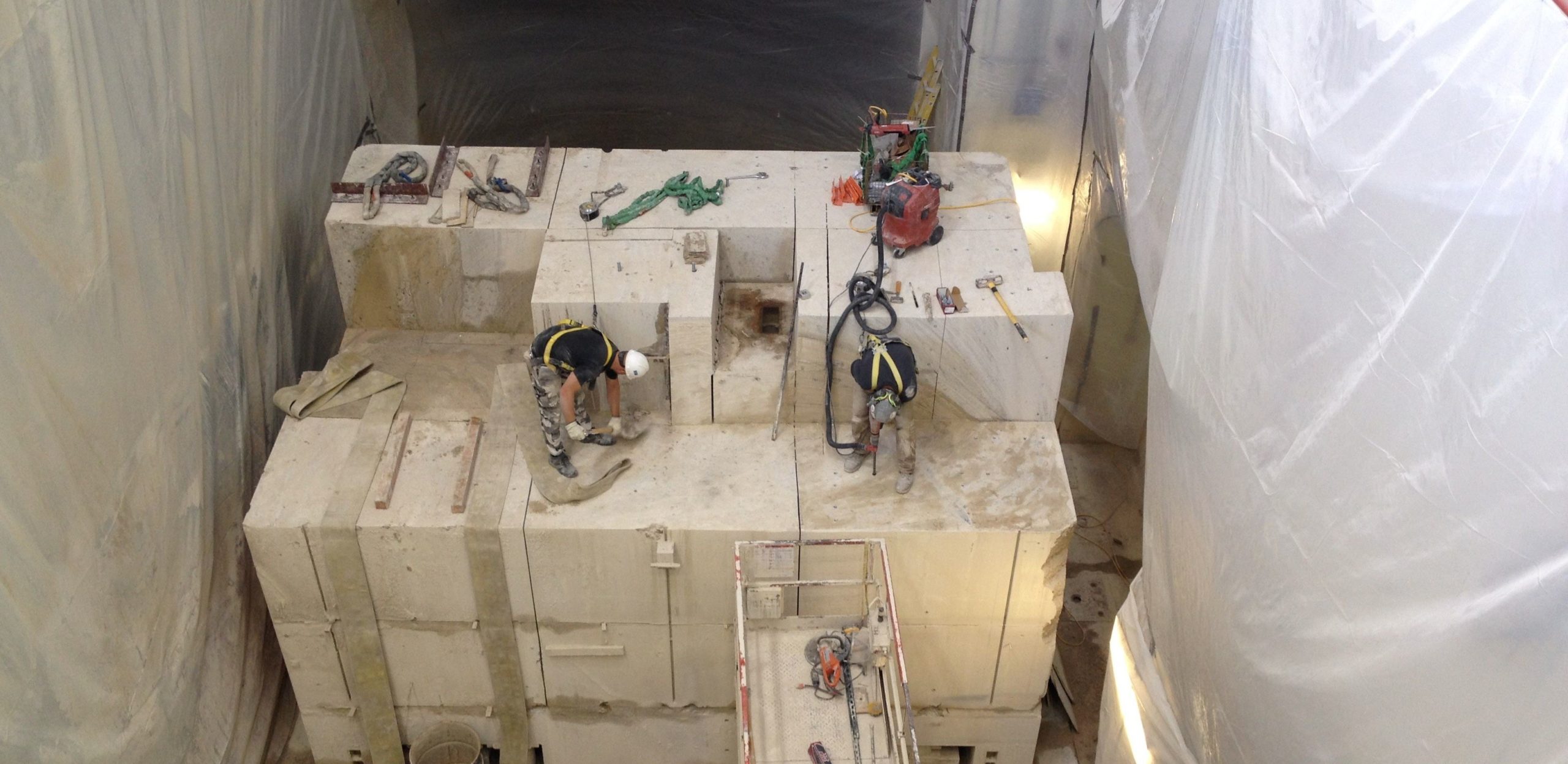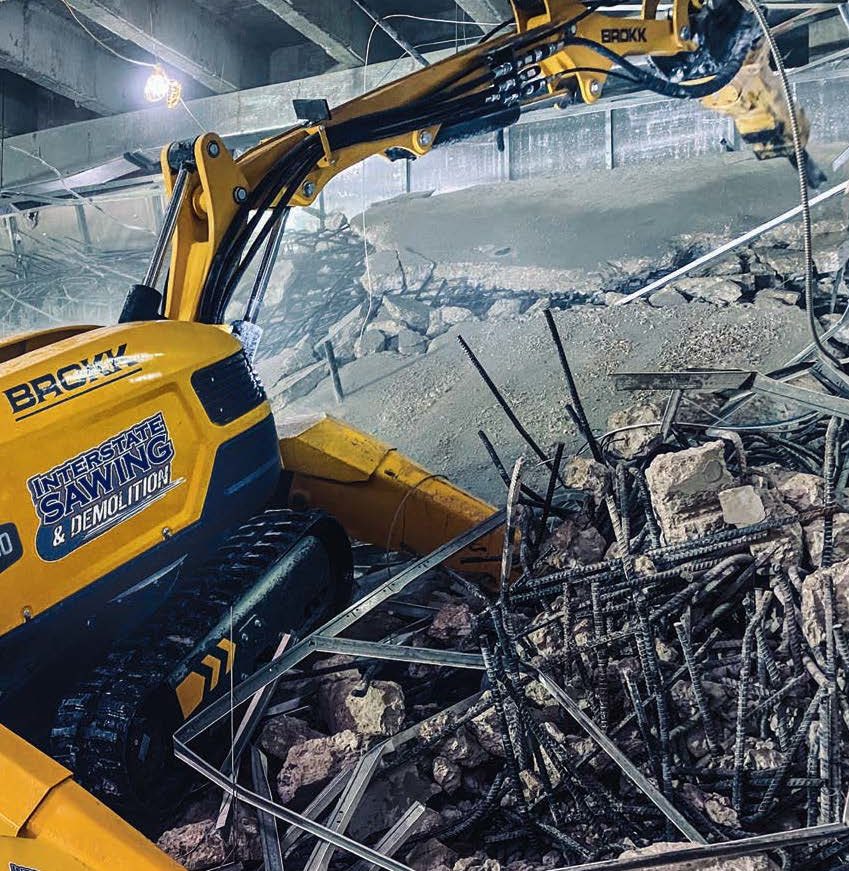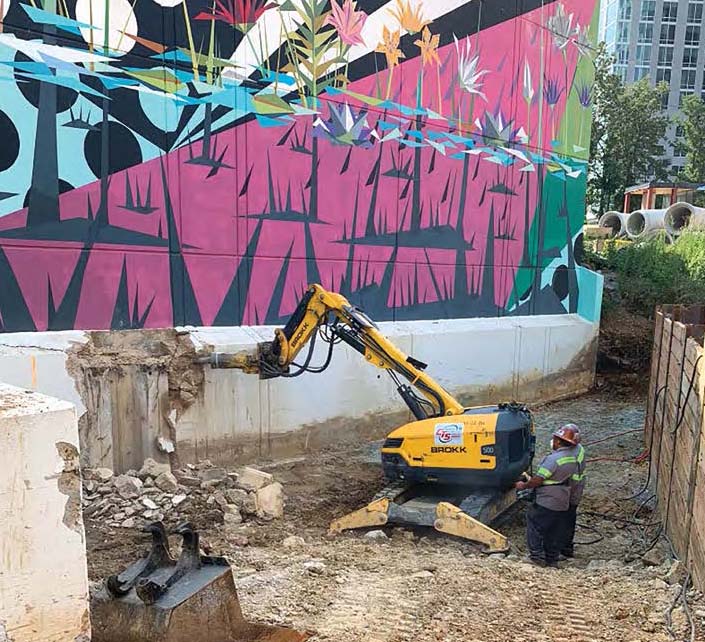
Down to a Science

Concrete Cutter Removes 400-Ton Laboratory Door
A scientific research center recently laid down a huge challenge for one specialty contractor—cut and remove a giant 400-ton concrete shielding door from one of its laboratories. Fermi National Accelerator Laboratory, located on 6,800 acres in Batavia, Illinois, is the premier particle physics and accelerator research center in the United States. Operated by the U.S. Department of Energy and the Fermi Research Alliance (a consortium of groups that include the University of Chicago and Universities Research Association), Fermilab conducts high energy physics experiments using powerful particle accelerators to expand humanity’s understanding of matter, energy, space, time and the origins of the universe.
Ryan Schultz, a project engineer at Fermilab, was given the task of converting an existing building into a long-term storage facility for “neutrino horns” and “targets” after they are used. A neutrino horn is a high-current electromagnet that physicists use to focus particles which decay to neutrinos, producing intense beams of neutrinos to destinations hundreds of kilometers away.
“Neutrino horns are about the size of a large pick-up truck,” Schultz explained. “Roughly 4 feet wide, 6 feet tall, and 13 feet long, they weigh about 3,500 pounds.” Plans were formed to redesign and repurpose a large portion of the center’s C-Zero Detector Hall Building to handle and store these components. There was only one problem: a moveable concrete wall that weighed in excess of 800,000 pounds. The structure served as a giant door for a previous experiment, but now stood in the way of the renovation works.

The 400-ton concrete shielding door closed off the facility’s main storage room.
Fermilab hired general contractor Equity Construction Services, Inc., of Troutman, North Carolina, to oversee the project. Equity then subcontracted CSDA member Hard Rock Concrete Cutters of Wheeling, Illinois, to cut and remove the concrete shielding door that closed off the main storage room. The successful completion of this highly technical concrete sawing project required two years of planning. Hard Rock’s President, Jim Dvoratchek, worked with Schultz to evaluate and implement the appropriate plan for the project.
“We had to develop a removal process that satisfied the structural needs of the facility while maintaining a safe environment for our operators,” Dvoratchek said. “We were thrilled to take on a highly technical project with a fascinating scientific purpose.”
The small and constricted space in which the structure stood ruled out some traditional forms of demolition, so the decision was made to use wire sawing techniques. This prevented any potential health or environmental concerns.
In late September of 2014, Hard Rock operators arrived to begin demolition. Company superintendent, Doug St. Marie, oversaw the daily onsite work. “They rolled out the door on four 200-ton Hillman rollers, this thing was huge,” St. Marie recalled. “The block itself was 21 feet wide, 20 feet high and 13 feet deep of concrete. The bottom three feet were reinforced along the structure’s length by five embedded I-beams caged in 0.38-inch-thick steel plating. It was over 400 tons.”

The wire saw created 36 blocks, each weighing in excess of 16,000 pounds, which were removed by crane.
The first stage of work involved removing a top layer of 14 “shielding blocks” from the door. These blocks, each weighing approximately 6,000 pounds, were originally welded together. Hard Rock cut the welding and removed them one at a time. Fermilab provided an overhead 30-ton crane with an operator that lifted the pieces out of the three-story pit with rigging straps and onto a truck parked on a loading dock adjacent to the facility.
The second stage involved sawing the bulk of the structure. The contractor utilized a Hilti-Plattner wire saw with wire supplied by Diamond Tools Technology. The operation required four vertical cuts and four horizontal cuts on the upper 14 feet of the door. The vertical cuts covered 13 square feet each, and the four horizontal cuts covered 14 square feet each. In order to set the wire for specific cuts, 2-inchdiameter holes were made with a Hilti DD-200 core drill through the width and length of the structure using continuous tubing. In total, two holes were cored through 21 feet of concrete, and another two holes were cored through 13 feet of concrete. Plastic sheeting was hung on all four sides of the work area to prevent debris and slurry water from contaminating the surrounding areas of the storage facility.
The team averaged approximately one cut every eight hours, with necessary down time to reset the wire, perform saw maintenance and adapt safety protocols to changes in site conditions. Concern over hazardous dust emanating from the door during the sawing process was abated by the use of a water recovery system. Each of the 36 16,000-pound blocks was removed by crane to waiting trucks on the loading dock.

Steel plating measuring 0.38 inches thick and 3-foot I-beams lined the bottom section of the structure.
The third and final stage involved cutting the base of the door. The bottom 3 feet proved to be the cutting contractor’s most challenging part of the project, given the significant amount of rebar and steel within the concrete. Steel plating measuring 0.38 inches thick lined the entirety of the bottom section and within the concrete were five 3-foot I-beams, forming a hard base to the door. Operators sawed the section into three blocks, weighing an average of 25 tons each. Once these pieces were lifted out, area cleanup commenced and the project was finished successfully.
By the end of the job, operators had cored approximately 60 feet of concrete and cut approximately 2,132 square feet of concrete with the wire saw.
Hard Rock operators employed standard safety-related personal protective equipment when working on the facility floor: steel-toed boots, hard hats, safety glasses, hearing protection and work gloves. For those working on top of the structure, retractable full-body harnesses were provided as a preventative measure against potential falls. All workers evaluated their surroundings at all times and used extreme caution when dealing with the wire saw, rigging blocks to the crane and moving around on the top of the structure. Due to the commitment of all parties involved, there were no injuries during the course of the project.
The general contractor removed the block pieces to Fermilab’s on-site dump, making available over 400 tons of concrete and steel to be repurposed for other shielding needs around the lab. Hard Rock’s work was completed on time to the satisfaction of Fermilab and Equity Construction Services. When asked about his experience with the cutting contractor, Schultz said, “Hard Rock ran like a well-oiled machine! They determined the best type of diamond wire to use at the beginning of the project and there were no major issues during the cutting process. The work performed was very impressive.”
Company Profile
A CSDA member since 1989, Hard Rock Concrete Cutters, Inc., has been in business for 28 years. The company is based in Wheeling, Illinois, and services the entire Chicagoland area. Hard Rock Concrete Cutters employs 58 employees, has 28 trucks and offers the concrete cutting services of slab sawing, core drilling, wall sawing, hand sawing, wire sawing, grinding, concrete polishing, staining and GPR imaging. The company is a CSDA Certified Company and employs CSDA Certified Operators.
Resources
General Contractor:
Equity Construction Services, Inc.
Sawing and Drilling Contractor:
Hard Rock Concrete Cutters, Inc.
Wheeling, Illinois
Phone: 847-850-7710
Email: jimd@hardrockconcretecutters.com
Website: www.hardrockconcretecutters.com
Methods Used: Wire Sawing, Core Drilling














